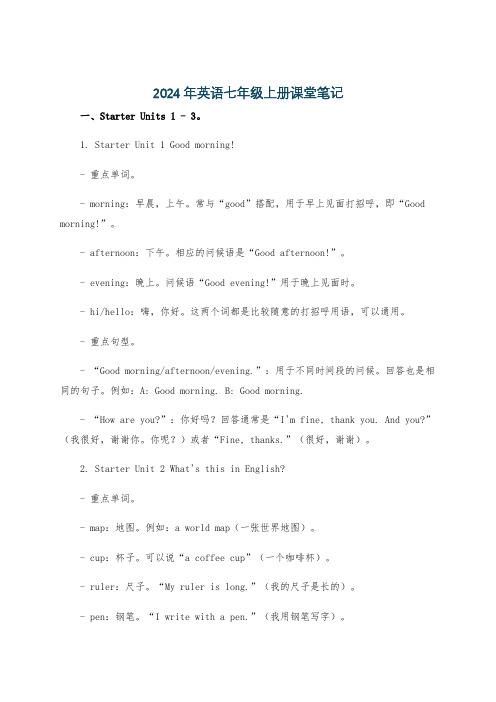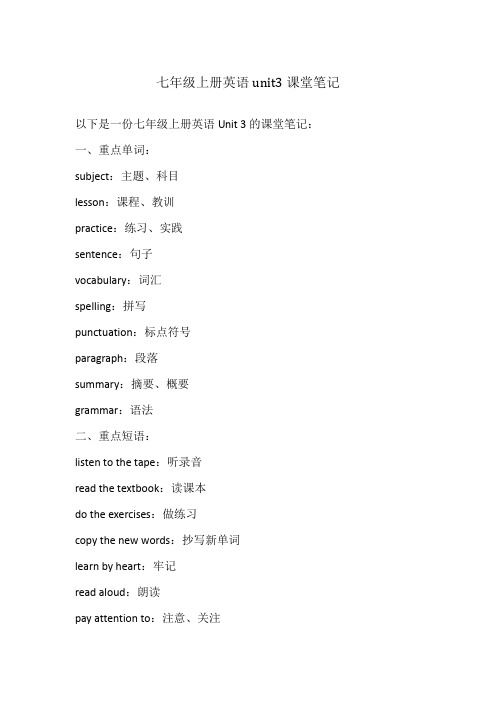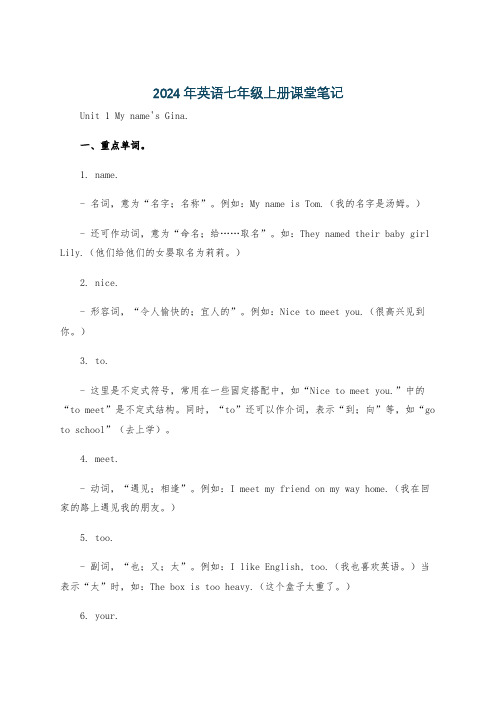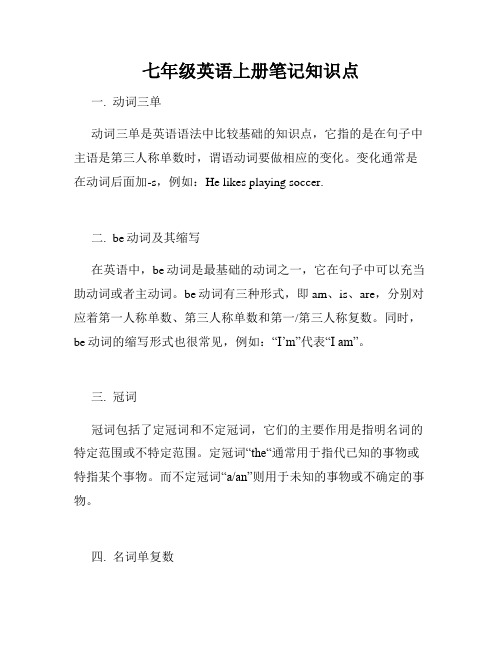七年级英语备课笔记
初一英语unit2笔记

初一英语unit2笔记标题:初一英语Unit 2笔记一、引言初一英语Unit 2的学习内容主要围绕日常生活中的一些基本情境展开,包括介绍人物、描述事物以及表达情感等。
本单元的词汇和语法点较为基础,但对于刚刚接触英语的学生们来说,仍然具有一定的挑战性。
通过本单元的学习,学生们将能够更准确地使用英语表达自己的想法和感受。
二、重点词汇1. 人称代词:我(主格),我们(主格),她,他,他们,你们(宾格),他们(宾格)2. 形容词性物主代词:我的,她的,他的,我们的,你们的,他们的3. 描述外貌特征的形容词:高,矮,胖,瘦,黑,白,漂亮,丑陋4. 描述事物的动词:有,在……里面,在……上三、语法知识本单元的语法知识点主要是人称代词和形容词的正确使用。
学生们需要了解人称代词需要放在句首,形容词则需要根据句子需要进行正确的排列和修饰。
例如:我有一个新书包,书包是名词,新的是形容词,所以应该放在名词前面。
此外,学生们还需要注意人称代词和动词的正确搭配,如我们正在看电影,电影是名词,所以应该是我们在看电影,而不是电影在看我们。
四、笔记整理为了更好地理解和记忆所学内容,学生们应该将重点词汇和语法知识点整理到笔记中。
例如:1. 人称代词+动词短语:我是学生,我们是朋友。
2. 形容词+名词:他的名字叫小明,我的书包是新的。
3. 人称代词+介词+名词:我在教室里面看书,他们在桌子上放了一个新玩具。
4. 人称代词+动词(主语+谓语+宾语)结构:你们吃了吗?他们在看电影。
五、练习与反馈在掌握了重点词汇和语法知识后,学生们需要进行相关的练习来巩固所学内容。
例如:可以找同学或朋友进行对话练习,用所学知识进行简单的交流。
同时,学生们也要及时反馈自己的学习情况,找出自己的不足之处并加以改进。
六、结语初一英语Unit 2的学习内容虽然基础,但对于学生们来说仍然具有一定的挑战性。
通过认真听讲、积极练习和及时反馈,学生们可以更好地理解和掌握所学知识,为以后的英语学习打下坚实的基础。
2024年英语七年级上册课堂笔记

2024年英语七年级上册课堂笔记一、Starter Units 1 - 3。
1. Starter Unit 1 Good morning!- 重点单词。
- morning:早晨,上午。
常与“good”搭配,用于早上见面打招呼,即“Good morning!”。
- afternoon:下午。
相应的问候语是“Good afternoon!”。
- evening:晚上。
问候语“Good evening!”用于晚上见面时。
- hi/hello:嗨,你好。
这两个词都是比较随意的打招呼用语,可以通用。
- 重点句型。
- “Good morning/afternoon/evening.”:用于不同时间段的问候。
回答也是相同的句子。
例如:A: Good morning. B: Good morning.- “How are you?”:你好吗?回答通常是“I'm fine, thank you. And you?”(我很好,谢谢你。
你呢?)或者“Fine, thanks.”(很好,谢谢)。
2. Starter Unit 2 What's this in English?- 重点单词。
- map:地图。
例如:a world map(一张世界地图)。
- cup:杯子。
可以说“a coffee cup”(一个咖啡杯)。
- ruler:尺子。
“My ruler is long.”(我的尺子是长的)。
- pen:钢笔。
“I write with a pen.”(我用钢笔写字)。
- orange:作名词时,意为“橙子,橘子”;作形容词时,意为“橙色的”。
例如:an orange(一个橙子),an orange coat(一件橙色的外套)。
- 重点句型。
- “What's this in English?”:这个用英语怎么说?回答:“It'sa/an...”。
例如:A: What's this in English? B: It's a pen.- “Spell it, please.”:请拼写它。
七年级上册英语unit3课堂笔记

七年级上册英语unit3课堂笔记以下是一份七年级上册英语Unit 3的课堂笔记:一、重点单词:subject:主题、科目lesson:课程、教训practice:练习、实践sentence:句子vocabulary:词汇spelling:拼写punctuation:标点符号paragraph:段落summary:摘要、概要grammar:语法二、重点短语:listen to the tape:听录音read the textbook:读课本do the exercises:做练习copy the new words:抄写新单词learn by heart:牢记read aloud:朗读pay attention to:注意、关注learn…by…:通过…学习…take notes:做笔记look up the word in a dictionary:在词典中查找单词三、重点句型:1、How do you study for a test? 你怎样为考试做准备?2、I usually study by working with a group. 我通常通过小组合作来学习。
3、It helps me to learn better. 它能帮助我学得更好。
4、What’s your favorite subject? 你最喜欢的科目是什么?5、I like English best because it’s easy for me. 我最喜欢英语,因为对我来说它很容易。
6、The teacher said that the earth goes around the sun. 老师说地球绕着太阳转。
7、What do you think of the suggestion? 你对这个建议怎么看?8、It’s a good way to improve your English. 这是提高英语水平的一个好方法。
七年级英语上册第二单元备课笔记

Unit 2 Is this your pencil?语言要点:1. --- Is this your pencil?--- Yes, it is. / No, it isn't.2. --- What's this in English?--- It's a pen.3. --- How do you spell it?--- P-E-N.文化背景知识介绍In China, if we find something valuable in the street we usually would give it to the police. In the United States, it always depends on where you find it.The general rules is to contact the person in authority at the place you find the item. The person in authority (such as shop clerk) will follow theappropriate lost and found procedures (of the store).·In a store: Contact a shop clerk.·On the street: Contact the police if the item is valuable.·In a restaurant: Contact the waiter.·On a bus,: Contact the bus driver.·In a classroom: Contact the teacher.·In a hotel: Contact the hotel clerk.Some places, such as railway stations or airports, have a lost and found office where all lost property is kept. If you have lost something in the station or airport, you would probably first look in the lost and found office.课外任务请你在班上设立一个失物招领处(Lost & Found),调查一下班里的同学最近丢失或捡到了什么?用表格的方式帮助他们寻找丢失的东西或失主。
2024年英语七年级上册课堂笔记

2024年英语七年级上册课堂笔记Unit 1 My name's Gina.一、重点单词。
1. name.- 名词,意为“名字;名称”。
例如:My name is Tom.(我的名字是汤姆。
)- 还可作动词,意为“命名;给……取名”。
如:They named their baby girl Lily.(他们给他们的女婴取名为莉莉。
)2. nice.- 形容词,“令人愉快的;宜人的”。
例如:Nice to meet you.(很高兴见到你。
)3. to.- 这里是不定式符号,常用在一些固定搭配中,如“Nice to meet you.”中的“to meet”是不定式结构。
同时,“to”还可以作介词,表示“到;向”等,如“go to school”(去上学)。
4. meet.- 动词,“遇见;相逢”。
例如:I meet my friend on my way home.(我在回家的路上遇见我的朋友。
)5. too.- 副词,“也;又;太”。
例如:I like English, too.(我也喜欢英语。
)当表示“太”时,如:The box is too heavy.(这个盒子太重了。
)6. your.- 形容词性物主代词,“你的;你们的”。
例如:Your book is on the desk.(你的书在桌子上。
)7. his.- 形容词性物主代词,“他的”。
例如:His name is Jack.(他的名字是杰克。
)8. her.- 形容词性物主代词,“她的”。
例如:Her pen is red.(她的钢笔是红色的。
)二、重点短语。
1. name's = name is.- 例如:My name's Gina. = My name is Gina.(我的名字是吉娜。
)2. nice to meet you.- 用于初次见面时的问候语,回答是“Nice to meet you, too.”(很高兴见到你。
七上英语2024新版教材笔记

七上英语2024新版教材笔记人教版七年级上册英语2024新版教材笔记。
一、预备篇。
1. 字母。
- 26个英文字母的大小写书写规范。
大写字母占上两格,如A、B、C等;小写字母有的占一格(如a、c、e等),有的占两格(如b、d、h等),还有的占三格(如f、j等)。
- 字母的读音,注意元音字母(a、e、i、o、u)和辅音字母的发音区别。
例如,元音字母在开音节和闭音节中的发音不同。
2. 简单的问候语和自我介绍。
- Hello/Hi:用于熟人或陌生人之间的简单问候,比较随意。
- Good morning/afternoon/evening:根据不同的时间段使用,分别是早上、下午、晚上的问候语,较为正式。
- 自我介绍:“I'm...”(I am的缩写形式),后面接自己的名字,例如“I'm Tom.”二、Unit 1 My name's Gina.1. 重点单词。
- name:名字,可用于询问他人名字,如“What's your name?”- to:在这里是不定式符号,在“Nice to meet you.”中无实际意义。
- meet:遇见,相逢。
- too:也,用于句末,如“I'm fine, too.”- your:你的,你们的,是形容词性物主代词,后面要接名词,如“your name”。
- his:他的;her:她的,这两个也是形容词性物主代词。
2. 重点句型。
- What's your name?- 回答:“My name's...”或者“I'm...”。
- Nice to meet you.- 回答:“Nice to meet you, too.”- Is he/she...?- 回答:“Yes, he/she is.”或者“No, he/she isn't.”例如“Is he Tom? Yes, he is.”三、Unit 2 This is my sister.1. 重点单词。
七年级英语上册笔记知识点

七年级英语上册笔记知识点一. 动词三单动词三单是英语语法中比较基础的知识点,它指的是在句子中主语是第三人称单数时,谓语动词要做相应的变化。
变化通常是在动词后面加-s,例如:He likes playing soccer.二. be动词及其缩写在英语中,be动词是最基础的动词之一,它在句子中可以充当助动词或者主动词。
be动词有三种形式,即am、is、are,分别对应着第一人称单数、第三人称单数和第一/第三人称复数。
同时,be动词的缩写形式也很常见,例如:“I’m”代表“I am”。
三. 冠词冠词包括了定冠词和不定冠词,它们的主要作用是指明名词的特定范围或不特定范围。
定冠词“the“通常用于指代已知的事物或特指某个事物。
而不定冠词“a/an”则用于未知的事物或不确定的事物。
四. 名词单复数英语名词的单复数有规可循,但也有很多例外。
例如,名词后面加-s通常表示复数形式,而以s、x、z、ch、sh结尾的名词,其复数形式要在末尾加-es,例如:bus -> buses。
五. 形容词和副词的比较级和最高级在英语中,形容词和副词的比较级和最高级也是需要掌握的内容。
一般规则是在形容词或副词后面加-er/-est来表示比较级和最高级。
六. 现在进行时现在进行时指的是现在正在进行的动作或状态。
它需要用be 动词和现在分词来构成。
例如:I am studying English.七. 情态动词情态动词是英语中重要的语法结构,包括can、may、must、shall、will、should、would等。
它们的主要作用是用来表示说话人对某件事情的推测、认为必须、推荐等态度。
八. 名词所有格名词所有格是英语中表明所属关系的一种结构,通常在名词后面加上’ s来构成。
例如:This is Tom’s book.九. 疑问词疑问词是用于构成疑问句的词汇,包括what、who、when、where、why等。
在使用疑问词构成疑问句时,需要注意其位置与语序。
英语七年级上册课堂笔记

英语七年级上册课堂笔记Unit 1: Hello!重点单词:hello,hi,goodbye,meet,nice to meet you,what’s your name,my name is…重点句型:Hello!/Hi!/Goodbye! 用于打招呼和告别。
Nice to meet you. 用于表达认识新朋友的喜悦。
What’s your name?/My name is…用于询问和介绍自己的名字。
注意事项:在回答“What’s your name?”时,可以用“My name is…”来回答。
在介绍自己的名字时,也可以用“I’m…”来表达。
注意句子的语调和重音。
Unit 2: Is this your pencil?重点单词:pencil,book,eraser,pen,pencil case,backpack,Is this/that your…? Yes,it is./No,it isn’t.重点句型:Is this/that your…? 用于询问某物是否属于某人。
Yes,it is./No,it isn’t. 用于回答询问。
注意事项:在回答“Is this/that your…?”时,可以用“Yes,it is./No,it isn’t.”来回答。
注意名词的单复数形式。
Unit 3: This is my sister.重点单词:sister,brother,mother,father,grandfather,grandmother,family,parents重点句型:This is my…用于介绍家庭成员。
Who is she/he? 她/他是谁?回答用She/He is…她/他是……。
注意事项:在介绍家庭成员时,可以用“This is…”来介绍。
在回答“Who is she/he?”时,可以用“She/He is…”来回答。
- 1、下载文档前请自行甄别文档内容的完整性,平台不提供额外的编辑、内容补充、找答案等附加服务。
- 2、"仅部分预览"的文档,不可在线预览部分如存在完整性等问题,可反馈申请退款(可完整预览的文档不适用该条件!)。
- 3、如文档侵犯您的权益,请联系客服反馈,我们会尽快为您处理(人工客服工作时间:9:00-18:30)。
七年级英语备课笔记Starter U1 Good Morning1. Names: 姓名与性别英语人名中带有性别特征。
从姓名基本可以看出性别。
2. Greet people1) Good morning/ afternoon/ evening(见面)问候语但Good night(晚安,再见)2) A: Nice to meet you. B: Nice to meet you, too.3)A: How are you? B: Im fine/ ok. Thanks.4) Hello, Hi3. Letters: A-H (书写,发音)4. 字母A,E在单词中的发音及含有相应发音的字母(P S4)字母A在单词中的发音[ei], [] 及含[ei]音的字母(A, H, J, K,)字母E在单词中的发音[i:], [e],及含[i:]音的字母(B, C, D, E, G, P, T, V, Z) ;含[e]音的字母(F, L,M, N, S,X,Z)Starter U2 Whats this in English?1.介绍身边事物及中英文拼写Eg 1) A: Whats this in English?B: Its a schoolbag.A: Spell it, please. (How to spell it?)B:s-c-h-o-o-l-b-a-gEg 2) A: Whats this in English?B: Its an orange.A: Spell it, please. (How to spell it?)B:o-r-a-n-g-eEg 3) A: Whats that in English?B: Its a jacket.A: Spell it, please. (How to spell it?)B: J-A-C-K-E-T.补充:1) in表示用(语言)。
Eg: A: Whats that in English? B:Its a 床。
另一种表达方式:A:Whats the English for 电脑?B:Its a computer.2.不定冠词a 和an(泛指一个)元音(发音)开头的字前用an,辅音(发音)开头的字前用aa key, a map, a picture, a book, a sheepan apple, an orange, an egg, an umbrella, an hour, an honest man,3.Letters: I-R (书写,发音)4.字母A, E, I,O在单词中的发音及含有相应发音的字母(P S8)字母I在单词中的发音[ai]、[i], 及含[ai]音的字母( I, Y)字母O在单词中的发音[u]、[],及含[u]音的字母(O)Starter U3 What color is it?1.辨识颜色(颜色名词;有关事务颜色的描述)Eg: red, green, blue, orange, yellow, pink, purple, black, white, gray, brown,2.Letters: S-Z (书写,发音)3.元音字母(A, E, I,O, U)与辅音字母4.字母A, E, I,O,U在单词中的发音及含有相应发音的字母(P S12)字母U在单词中的发音[ju:]、[], 及含[ju:]音的字母(Q, U, W)5.What疑问句及回答Eg: 1)--Whats this? --Its a TV.2)--What color is it? --Its red.6. 介词in在里面的用法Eg: 1) E in the eveningU1 My name is Gina.1. 自我介绍:姓名:1) Im Gina. 2) My name is Gina.注:1)姓在后last name,名在前first name年龄:1) I am 12 this year. 2)Im 12 years old this year.2. 见面问候1)Hello / Hi2)Good morning/afternoon/ evening.3)Nice to meet/see you3.相互介绍(认识):询问姓名(make friends交朋友)1) Whats you name? 2) Your name, please?3) May I know your name?Eg: A: Hello, Im Gina. Whats your name?B: My name is Cindy.A: Hi, Cindy. Nice to meet you.B: (Hi, Gina.) Nice to meet you too.4.电话号码的询问与告知Eg: 1) A: Whats your telephone number, Gina? B: Its 281-91762) A: Whats her telephone number B: (Her phone number is) 806-5224注:1)电话座机号码通常分为两部分2)直接说每个数字,但数字0通常念为字母o。
3)如果两个相同的数字x连着出现,念double x5.基数词(0~9):zero,one, two, three, four, five, six, seven, eight, nine6.人称代词、物主代词(表一)7.ID card 身份证,school ID card学生证Eg: 1) Please show me your ID card.2) Do you have your school card with you?3) Your ID card, please.8. be动词的一般现在时与人称代词的对应关系:I am; you, we, they--- are; he, she itisU2 This is my sister (主题:My family)1. 家庭及家庭成员:grandparents, grandfather/grandpa, grandmother/grandma, parent, father/ dad/ papa, mother/mom/ mama/, aunt, uncle, brother, sister, cousin, son, daughter, who family, people, member2. 指示代词:近指:(单数)this, (复数) these; 远指:(单数)that, (复数)those注意:在下文中或回答指示代词的问句时,用人称代词:单数this, that用it,复数these,those用they。
Eg: 1) This is my friend, Jane.2) These are my friends.3) Thats my brother.4) Are those your books?5)-- Whos she? -- Shes my sister.3. 名词的复数形式(规则:1.)一般情况词尾+s :book-- books mouth---mouths house---houses girl---girls2).以s 、sh 、ch 、x结尾的+ es :class--- classes,dish- dishes, match----matches ,watch- watches, box----boxes,fox- foxes3).辅音字母+ y结尾的变y为i, +es:city---cities country----countries party----parties factory----factories4.)以o 结尾的词+es的只有以下词:heroes, Negroes, tomatoes, potatoes zeroes/zeros以o 结尾并且词尾有两个元音字母+s radios, zoos, bamboos ,(pianos ,kilos photos)5)以f,fe 结尾的变f或fe为v +es :thief- thieves, wife-wives, life-lives, knife-knives, wolf-wolves, half-haves, leaf-leaves, shelf- shelves(记忆:The thiefs wife killed three wolves with some leaves and knives in half of her life.)不规则的名词复数形式:1)manmen, womanwomen, toothteeth, footfeet, goosegeese childchildren, mousemice,2.)单复数相同: sheep, deer, Chinese, Japanese Swiss.3)以man, woman 修饰名词构成合成词时,两个词都变化. man servantmen servants. 别的是前一名词限制后一名词时,只后一名词弯复数boy/girl students4. ---Have a good/nice/happy day! Have a good/nice/happy time. Have a good evening.( 祝你们玩得开心。
)--- You too. (你也是。
)5. 介词in(在里面),Eg: 1)My grandfather and grandmother are in the first photo.2) In the next picture are my brothers, Bob, and Eric.6. Family Tree(grandparents: grandfather/grandpa, grandmother/grandma; parents: father/dady/dad/papa, mother/mommy/mom/mama; uncle, aunt; son, daughter, brother(elder brother/younger brother/baby brother), sister(elder sister/younger sister /baby sister); cousin [kzn] n. 堂[表]兄弟姊妹; nephew[nefju:] n. 侄子,外甥; niece [ni:s] n. 外甥女;侄女;)7. 阅读理解(P11):阅读一篇与家有关的短文,完成句子或回答问题。
